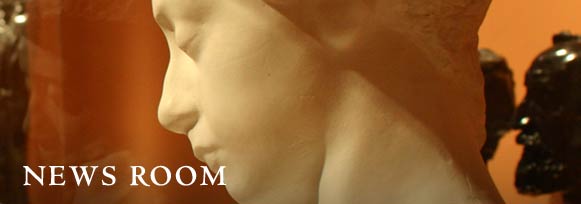Exhibition Presents Asian Art from the Cantor Collection
Border Crossings: From Imperial to Popular Life
January 30, 2013–February 2, 2014
Stanford, Calif. — A new exhibition at the Cantor Arts Center explores how boundaries between social classes and identities are challenged and transcended. “Border Crossings: From Imperial to Popular Life,” focusing on 18th- and 19th-century China and Japan, includes more than 40 works. The exhibition opens on January 30 and continues through February 2, 2014.
Two sets of 18th-century Chinese paintings from the Cantor’s collection are on view for the first time to the public. Scholarly perspectives and tastes have changed, so that recent research and evaluation by Cantor’s curatorial staff have shed new light on these beautiful works and rescued them from obscurity. Both “Ten Beauties” and “The Life and Miracles of the Goddess Mazu” demonstrate how workshop artists outside palace walls reproduced the subjects and styles of imperial court paintings in order to fulfill commissions by patrons of a rising social class. The rich material world depicted in the paintings is brought to life in the gallery by a complementary presentation of costumes, bronze and porcelain vessels and other decorative arts.
In addition, the exhibition features Japanese woodblock prints of civil life, urban scenes and coveted styles that reflect a growing commercialism during the Edo period. Prints of the floating world (ukiyo-e), produced rapidly at a low cost as compared to formal paintings, were especially responsive to trends and fashions. This floating world often escaped the ruling shogunate’s regimentation, which included strict class depictions and other control of content in artworks.
To address class and gender restrictions that still exist today, the exhibition also features a work from the “Identity Exchange” series by Chinese contemporary artist Cang Xin. In his photograph, the artist poses in a traditionally female costume, stepping into another profession and identity.
On March 8 at 2 p.m., Yu-chuan “Phoenix” Chen, Stanford Ph.D. candidate in art and art history, presents the month’s Spotlight on Art. Chen will discuss a work from the exhibition in the Madeleine H. Russell Gallery, where the exhibition is on view.
Visitor information
The Cantor Arts Center is open Wednesday–Sunday, 11 am–5 pm, Thursday until 8 pm. Admission is free. The Cantor is located on the Stanford campus, off Palm Drive at Museum Way. Parking is free after 4 pm. weekdays and all day on weekends. Information: 650-723-4177, museum.stanford.edu
# # #
Notes to editors:
• To arrange interviews and for further information, contact Anna Koster, Head of Communications, Cantor Arts Center, 650-725-4657, akoster@stanford.edu
• For high-resolution publicity images, contact PR Assistant Manager Margaret Whitehorn, Cantor Arts Center, 650-724-3600, mmwhite@stanford.edu
About the Cantor Arts Center
Take a journey around the world: from Africa to the Americas to Asia, from classical to contemporary. There is so much to discover at the Cantor. With 24 galleries plus sculpture gardens, collections that span 5,000 years, a world-famous Rodin collection, changing exhibitions, frequent tours and free programs, there is something for everyone at the Cantor. And admission is free for everyone.

Artist unknown (China, Qing Dynasty 1644-1912) Ten Beauties, late 18th century. Ink and color on silk. Stanford Museum Collections, 2012.581.



